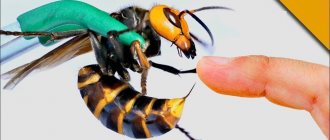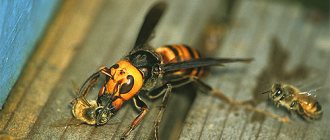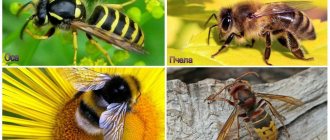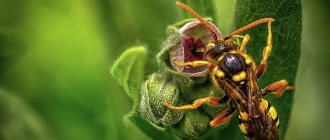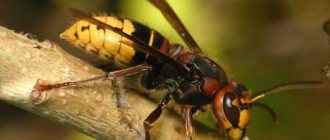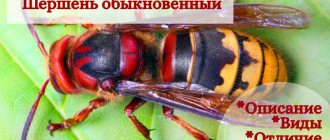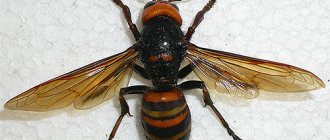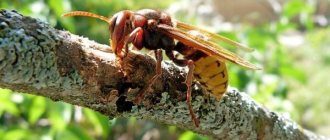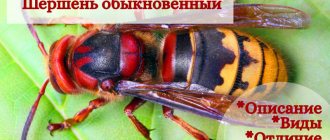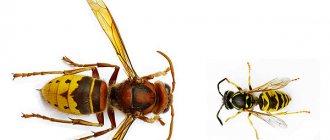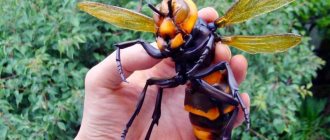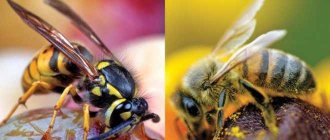Japanese hornet
Giant insects are not only a figment of the sick imagination of science fiction writers, but also a reality of life on earth. This is confirmed by the huge Far Eastern hornets, their other name is Vespa Mandarinia Japonica - Japanese hornets, and the Japanese themselves called them “suzumebachi”, which means “sparrow-bee”. This is a huge arthropod insect, dangerous with its poison even for humans. Also on this list are the Japanese giant wasp and the Japanese killer bee. Every insect that is potentially dangerous to humans does not actually hunt people, but rather protects its habitat. A person is stung by these insects due to his own negligence. True, for the “bitten” this is little consolation. To avoid defeat, you need to know a little more about their habitat and their habits.
The danger of the poisonous substance found in the hornet's sting
The hornet is a thrifty insect that conserves its poison. With one hornet bite, only a small drop of poison enters the human body. However, if this is necessary and the hornet senses great danger, it can sting its victim again. This is probably why some people think that the hornet has more than one sting.
Many people wonder whether this insect has its sting in the body of the victim? The answer to this is clear: no. Since the insect's sting is thin and has a smooth structure, it can be easily pulled out from under the skin in a matter of seconds. In this case, the hornet can attack the enemy with the same sting again and again. Being in a panic, a person can kill a hornet. But if this representative of the wasp family manages to release “alarm” pheromones into the air, a person may be in serious danger. After all, the smell of these substances will attract relatives of the hornet, which can severely bite the enemy.
For humans, even one bite can be dangerous. The poison is especially dangerous for people prone to allergic reactions. After all, the poison contains the following toxic components:
- Acetylcholine is a transmitter of nervous excitation from the cells themselves to the muscles. It is because of its high concentration in the poison that a person experiences severe pain when bitten.
- Histamine is a substance that provokes a severe allergic reaction. In addition, it contains amino acids that enhance this reaction and accelerate its consequences.
- Phospholipases - this component destroys capillaries at the cellular level. As a result, bleeding and suppuration may appear in the affected area.
- Components that increase heartbeat. As a result, the pulse quickens and the poison begins to spread faster throughout the victim’s body.
To take off faster after being stung, hornets sting while bending over. They fly away and leave the enemy alone with his pain. The hornets do not leave the victim a single chance to retaliate.
If representatives of this family bite in some parts of the body, a person faces serious danger. For example, in the head, throat, chest, stomach or eyelid. Even if the victim is resistant to allergic reactions, the hornet's venom can cause severe swelling. Because of it, the airways and other vital organs can become compromised, leading to death.
Therefore, a person should not forget that the sting is a protected organ of the hornet. The poison from it can seriously harm the body and lead to serious consequences. To prevent being bitten, it is better to stay away from these insects.
Japanese hornet suzumebachi
This species of wasp lives in the Far East, and since all of Japan is the Far East, they had the honor of giving a name to this quarrelsome hymenoptera, which takes 40 lives of the Japanese population every year. The statistics are very frightening because they indicate a certain sad norm. What kind of killer insect is this:
- scientists named it Vespa mandarinia;
- belongs to the class of insects;
- from the order Hymenoptera;
- phylum arthropod;
- family of wasps are true;
- genus of hornet.
Japanese hornet suzumebachi
For your information! Based on this classification, it becomes clear that the Japanese giant wasp and the Japanese giant hornet are the same insect that plagues the Japanese with their attacks. However, not only the Japanese, because its habitat is China, Nepal, the highlands of Sri Lanka and Primorye Russia.
What does a giant Japanese wasp look like?
The Far Eastern hornet Vespa mandarinia, which is how this insect, notorious throughout Asia, is classified, looks terrifying:
- The length of an average individual is 5 cm, and especially large ones reach 6-6.6 cm.
- The span of its membranous wings reaches 6-7 cm.
- The head is large, in addition to the 2 eyes that all wasps are equipped with, it has 3 more eyes located slightly above the main ones: 2 on the sides and 1 in the center.
- The head is also equipped with very powerful jaws, with which this predatory insect kills its prey and dismembers it.
- The sting through which the Japanese giant hornet injects poison into its victim reaches 6 mm - approximately the size of an adult's little fingernail. It is located at the end of the back of the insect's body.
- The color is not much different from the usual color of the wasp - yellow stripes on a black background and dark yellow membranous wings.
- The chest of the Far Eastern hornet is covered with a powerful chitinous shell and is equipped with three pairs of jointed legs.
Giant Japanese wasp
Wasps and hornets: what are the differences?
Externally, the hornet and the wasp are very similar to each other. They are easy to distinguish by size, since the wasp is much smaller than the hornet. The dimensions of the latter are twice the body length of the wasps. There are also differences in color; hornets have more brown shades in the head and chest area. They also have large eyes, powerful jaws and a thin wasp-like waist. The wasp's head is smaller and narrower towards the base. Hornets have a larger head and a wide nape with an almost round shape.
In the southern regions of Russia there lives an insect very similar to the hornet wasp - Scolia. It is the same in size, but has a black color with orange stripes on the abdomen. This insect is completely safe for people and benefits people in agriculture. Scolia destroys beetle larvae that live in gardens and vegetable gardens. This insect can grow up to 45 mm.
What to do if bitten by a wasp
Types of hornet wasps
Despite the living conditions and the difference in size, all varieties of hornets have peculiarities in biology and anatomy characteristic of their species. We will highlight just a few of the most common types in the world, which are worth talking about in more detail.
- The common European hornet is the most representative of the hornets. The dimensions of its body can range from 2.5 to 3.5 cm. At rest, the wings of the insect are located along the body, transparent and shiny, small in size. Almost the entire body is brownish in color, with black and yellow stripes on top. This species always lives in large families.
- Oriental - their color is dominated by red-brown shades. The body length of the queen is 3 cm, and workers and males are slightly smaller. A characteristic feature of the color is a wide yellow stripe in the abdomen and a large yellow spot on the head from the eyes to the jaws. Nests are built in the ground and most often live in deserts and steppes, preferring a dry climate. They are considered the most beautiful among all species.
- Giant Asian - This species is considered the most dangerous among other species. The body size of the yellow hornet reaches 5–6 cm, and the wingspan is up to 7.5 cm. Its venom contains a large amount of toxins, so a bite can be fatal. On the abdomen, black and yellow tracks are clearly visible, and the head has a yellowish-ocher tint with red-brown jaws.
- Black (Dybovsky) - very similar to the common hornet. Its abdomen is completely black, its wings are brownish. They are less dangerous than the giant Asian ones, but they still pose a threat to humans. Among its fellows it is the only nest parasite. The queen climbs into other people's nests, kills the queen there and begins to control this nest. She does not raise her own family, but takes in other people's families.
What are hornets: species, where they winter and how they differ from wasps
Features of behavior
Since these insects live in large families, they form entire colonies. When danger comes for them, they mobilize and all rise together to defend the queen or swarm. This often happens even in the case of an alleged attack. At the first danger, an alarm pheromone begins to be released in the secretory glands. This substance promotes the active actions of other brothers in order to protect themselves from the attacks of enemies.
To avoid being attacked by a swarm of these stinging insects, you must avoid sudden movements near their nest. It is undesirable to allow an insect to die near your home. Otherwise, at the moment of danger, he will transmit an alarm signal and the entire colony will rush to attack.
It is best to treat insect nests with care and carefully observe them from the side. Their calm behavior does not cause them anxiety and they do not behave aggressively towards people
Features of the life of the Japanese hornet
They live and hunt in packs. Like bees, hornets have their own hierarchy:
- The queen is the head of the pack, she creates a colony, and all other individuals serve the same goal - to raise young animals.
- The Japanese huge hornet is a predatory insect that feeds on nectar only for dessert, and their daily menu should include bees, bumblebees and other insects that are inferior to it in size and succumb to their powerful jaws.
- Hornets live in nests that they make themselves from chewed tree bark. Usually these are gray hollow vessels with a hole that look like a sea shell. As soon as the nest is ready, the queen lays larvae, and then the whole flock is engaged in feeding and nurturing the larvae. It is during this period that hornets are especially aggressive.
- Hornets hunt strategically. First, scouts fly out and look for hives with bees. Soldier bees always try to neutralize scouts. If the hornets are discovered in time, then each of them is surrounded by a ball of bees; they swarm around it, creating a temperature inside the swarm of over 40°C, which kills the enemy. But, if the scouts are not destroyed, they will bring a flock of killers who will destroy all the inhabitants of the hive, even the bee larvae.
- In spring, the queen leaves her nest and looks for a place to create a new family. She makes the first clutch of eggs of the season, feeds and cares for them herself. When the young grow up, they begin to build a nest and care for subsequent clutches of larvae. This continues the cycle of creating new hornet colonies.
- Hornet families live only one year. When the young grow up, the young hornets mate. After mating, the males die, and the fertilized queens, having survived the winter or rainy season, lay larvae, and the cycle repeats.
- When hunting, they actively use their powerful jaws - mandibles, with which they crush their victims. The larvae feed only on the “meat” of other insects, while adults are omnivores and do not disdain meat and fish, as well as sweet fruits.
Storm of all bees
The huge hornet causes the most trouble to Japanese beekeepers. Honey bees (usually the European variety, which are more industrious and less aggressive) are a real delicacy for hornets. However, the prey is not only bees, but also the honey they produce, which the giant predator feasts on after the destruction of the hive.
If a scout hornet finds a residential hive with bees, it leaves odorous marks near it, and upon returning to the nest, it shows its fellows the way to the delicacy. After this, the murder hornets set off as a whole squad to destroy the hive.
In fairness, it is worth noting that some species of bees, in turn, also have a unique mechanism for combating hornets. However, it gives results only with a small number of attackers. If the hornets attack in significant numbers, the bees, alas, are powerless.
So, how does the bees' defense mechanism work? The defense of the hive consists of several stages:
- at the very beginning, when the giant hornet tries to enter the hive, several bees surround it;
- then others sit on them, and this continues until a huge ball of bees, up to 30-35 cm in diameter, grows around the hornet;
- parallel to this process, all the defenders of the hive actively move their wings, directing the air inside the ball - towards the aggressor - and heating it to 46-47 ° C, which is destructive for the hornet (the bees themselves can withstand heating up to 50 ° C).
The result of all these efforts is the death of the attacking predator from overheating within about one hour.
Despite this seemingly effective mechanism, bees are not able to cope with an entire squad of winged killers. That is why the Japanese huge hornet is considered to be the cause of serious losses for beekeeping farms in this country. Owners and workers of apiaries are doing their best to destroy hornet nests near the locations of honey beehives.
However, the struggle of beekeepers against an enemy insect often ends in loss: a huge hornet, due to its size, can fly away in search of food up to 10 km from its nest, and pursue the victim itself up to 5 km. Therefore, despite all human efforts, destroying the nests of a giant predator often does not produce significant results in protecting apiaries.
Why is the hornet of the genus Vespa mandarinia dangerous for humans?
Important! Japanese hornets use their stings for protection.
In any case, this is what famous entomologists, scientists who study insects, say. They advise that if you see a hornet nest, you should urgently leave this area, because the insect will regard their appearance as a desire to harm the larvae, and then the person will be attacked. The local population and visitors who have become victims of the stings of these giant insects do not agree with entomologists. Hornets strike with their toxic poison even far from their nest due to their bad character. A meeting between a person and a Japanese hornet does not bode well, so you should not expect that the hornet, sitting on your body, will simply flutter up and fly away. It will sting, and this is not only very painful, but also life-threatening, because the poison that it injects has the following composition and properties:
- Mandrotoxin is a neuroparalytic toxin that causes unbearable pain that torments the stung person for a long time, so that no pain relief helps.
- Histamines and the protein contained in the venom of this giant cause a violent allergic reaction that can only be blocked by injections of adrenaline. But, if a person is prone to allergies, then anaphylactic shock from the sting of this insect occurs almost instantly, so the outcome can be fatal. Most people who die from the Japanese hornet are allergy sufferers who did not get help quickly enough.
- Tissues affected by poison disintegrate very quickly under the influence of the protein contained in the poison. This process is difficult to stop, and people recover from a hornet for a very long time, because tissue necrosis, extensive hemorrhages, and often damage to internal organs occur.
The largest bumblebee in the world
Bumblebees are part of the bee genus and are one of the closest species to ordinary honey bees. The largest are the Asian ones, which are often called killer bumblebees or tiger bees due to their tiger-like coloring.
These insects are usually quite large in size:
- the body is about 30 mm long in females and 26 mm in males;
- the width is about 15 mm;
- The wingspan can reach 50 mm in the largest individuals.
Note! Giant killer bumblebees most often live in forests, groves and agricultural lands, since in this area it is more convenient for them to build nests, which are usually located in the crowns of trees. Bumblebees are dangerous, and their poison is quite strong. After being stung, a person can easily end up in the hospital
After being stung, a person can easily end up in the hospital.
Giant bumblebee, or tiger bumblebee, is a name most often found in Japan or China. Despite the development of medicine and the creation of new drugs, a relatively large number of people still die from attacks by representatives of this species, numbering in the hundreds all over the world. The bumblebee is a more aggressive insect, and there are cases when it attacked first. It has well-developed jaws, so it can not only sting, but also bite painfully. Bites, by the way, hurt the most. However, for residents of Russia and other CIS countries there is no reason to fear, since this class does not occur here. You should only be careful if you are planning a trip to Asian countries.
Giant killer bumblebees most often live in forests, groves and farmland
Important! The giant bumblebee has a relatively small wingspan, making it appear that this insect is unable to fly normally. This disadvantage is compensated by more frequent strokes, sometimes the frequency can reach more than 400 per second, which is almost impossible to notice with the naked eye. This class of insects feeds on the sap of trees and plants, as well as the nectar of flowers.
The sting remains with the bumblebee after the attack, and therefore it has the ability to use it repeatedly. During the attack, he injects a small amount of poison. Particularly dangerous can be cases where it gets into a vein or vessel. Then the poison acts on the body faster. This manifests itself as more severe pain and swelling. An affected person with an allergy needs immediate medical attention
This class of insects feeds on the sap of trees and plants, as well as the nectar of flowers. The sting remains with the bumblebee after the attack, and therefore it has the ability to use it repeatedly. During the attack, he injects a small amount of poison. Particularly dangerous can be cases where it gets into a vein or vessel. Then the poison acts on the body faster. This manifests itself as more severe pain and swelling. An affected person with an allergy needs immediate medical attention.
Giant bumblebees and hornets are insects of enormous size for their species. They are poisonous and can cause severe harm. Despite this, they rarely attack on their own, most often in order to protect their habitat. This is worth considering when planning a trip to Asian countries. In Russia they are rare, but still, whoever is warned is protected!
Killer insects
The hornet of the Vespa Mandarinia species is quite widespread in Southeast Asia, but depending on the geography of its habitat, it is divided into several subspecies. The most harmful of them is Vespa Mandarinia Japonica. This is an endemic insect that lives only on some islands of Japan. The remaining subspecies are found quite often in villages and suburbs of Southeast Asia. But these are not the only representatives with such a bad reputation as killer insects. Besides them, the following are quite dangerous:
- Africanized bees, which have a venom in their arsenal not much different from ordinary bee venom, but attack in a swarm and chase their prey until they kill it. It is almost impossible to escape from them if there is no shelter nearby. Moreover, you can’t hide from them in the water either; they swarm above the water, waiting to surface, and dig into your head.
- The human gadfly is an insect similar to a giant fly that, when bitten, injects its own larvae into the body of the victim. This is the only way they can grow and develop. The carrier of the larvae may not even realize it, but begins to get sick due to intoxication of the body and tissue necrosis. Any warm-blooded animal, including humans, can become a victim. Its habitat is Central and South America. By attacking herds of cattle, they make their meat unfit for food, which greatly annoys farmers.
- Stray ants are inhabitants of the African continent that migrate across Africa, devouring everything in their path. These are huge colonies where there can be up to 20 million individuals. And if you consider that their size is 2.5 cm, and their powerful jaws literally tear apart flesh, then meeting these migrants does not bode well for either people, animals, or reptiles. They literally sweep away all living things in their path.
- A kissing bug stings a person on the lips while he is sleeping. It is attracted to carbon dioxide released during respiration. When it bites, it infects its victim with the single-celled parasite Trypanosoma Cruzi. This parasite can cause heart failure due to its waste products. It's called Chagas disease and kills 12-13 thousand people every year. This insect has a fairly wide habitat - Australia, Central and South America, Africa, Asia.
As you can see, there are many insects that are dangerous to animals and humans, so you should know about the habits of the most common ones in order to avoid health problems and, possibly, a threat to life.
A disaster for humans or an adornment of nature?
In a global sense, giant Asian hornets are, of course, dangerous to people, but this danger is not critical, since it is entirely provoked by man himself. These insects are not very aggressive by nature; they will only attack in self-defense or protecting a nest.
Photo 14.
Hornets cause much more damage to apiaries, especially those where less aggressive European honey bees are bred. Sometimes hornets manage to destroy an entire bee family in a few hours, and therefore local beekeepers wage an ongoing systematic fight against them.
In general, the mortality rate from giant hornet bites is quite high: in some regions, up to 100 people die per year. But in fairness, it should be said that most of the dead are the same beekeepers who, without special means of protection, actively destroy hornet nests and, as a result, fall under their massive attacks.
A simple tourist who accidentally finds himself in the forest next to the Vespa Mandarinia hornet should not be afraid of this insect - it will not attack without a reason.
Photo 15.
In the West, many dietary supplements add synthetic substances similar to the secretion contained in developing hornet larvae. These components are believed to increase human endurance. However, there is no experimental evidence for these claims.
In conclusion, it should be noted that for wildlife, giant hornets are one of the most active natural orderlies. They successfully destroy many forest and agricultural pests, therefore, in most biocenoses - including agricultural lands - they are useful and deserve protection.
Photo 16.
Photo 17.
Photo 18.
Photo 19.
Photo 20.
Several dozen hornets completely destroyed a bee hive
The Asian giant hornet is the largest hornet in the world. If it sits on the hand, then its wings completely cover the palm, and the distance from the head to the end of the abdomen is quite consistent with the length of the little finger of an adult. It is not surprising that in Japan this wasp is called the “sparrow bee”: during the flight, the insect is very reminiscent of a small bird.
We can say with confidence that there is a connection between the size of this giant’s body and the severity of the consequences of meeting it: how big the largest hornet is, just as dangerous it is. Even a person who is not hypersensitive to insect venom may well die from its bites. Therefore, entomologists rightfully consider the giant hornet one of the most dangerous insects in the world.
According to statistics, in Japan alone, 40 to 50 people die annually as a result of giant hornet bites. Similar data are provided for individual districts of China where relevant records are kept. In Japan, even sharks are not responsible for the death of so many people.
Among other things, the huge hornet is a real scourge of many beekeeping farms
You have to fight it with extreme caution because of the serious danger of being stung
The relationship between the big hornet and humans has never been simple, and increased interest in it is often caused by a simple desire to tickle one’s nerves. Well, let's tickle...
Appearance of a huge Japanese hornet
It has a yellow head containing a pair of main eyes and three additional ones, and its body consists of brown and yellow stripes. The body length is 4 cm, the wingspan is up to 6 cm. Externally, the Japanese hornet looks like a wasp. The sting is straight, its length is 6.25 mm. After a sting, it does not remain in the skin, as is the case with a bee sting. Toxins and histamines contained in the poison can cause a severe allergic reaction.
Attention! If the injured person is not given first aid, this can lead to death.
The insect can be seen in gardens, garden plots and in the wild. It is also a frequent visitor to the apiary; it is a real killer of bees; you need to fight it, otherwise the family of hornets will destroy them all. Nests can be built in any place, as long as they are easy to access and protected from weather conditions.
[edit] Attack on bees
The Japanese huge hornet also attacks social insects - other hornets, bees. This hornet greatly harms Japanese beekeeping, as it attacks the hives of the European honey bee, which Japanese beekeepers breed in apiaries, since European bees collect more honey than Japanese bees.
When a scout hornet finds a beehive, it leaves marks near it. Then the “scout” informs the other hornets about the find, and within a short time a large number of hornets flock to the hive and attack the bees.
Within three hours, Japanese hornets can destroy an entire hive - 30 thousand bees. They then dismember the bee brood, which they feed to their larvae. Hornets also eat honey from bees' honeycombs.
The Japanese honey bee uses a special tactic to protect itself from hornets: when a scout hornet flies up to their hive, a ball of about 500 bees immediately forms around the hornet. They surround the hornet in a huge ball, inside which the temperature can rise to 47 °C. Since bees are able to maintain and withstand temperatures up to 50 °C, the hornet dies.
Lifestyle and nutrition
Each individual has its own responsibilities. Thus, the uterus is entrusted with the function of procreation; hard-working hornets are engaged in delivering food for it and the larvae. They feed on honey bees, agricultural pests, sugar-containing vegetables, and fruits. If a Japanese hornet discovers a hive of bees, it marks it with an odorous liquid so that it can later return here with its brothers. During the attack, they literally dismember their prey. Having dealt with large bees, the giants take honey and larvae for further food.
Interesting: in 90 minutes, 30 hornets can destroy an entire bee family. The giant will need no more than 60 seconds to destroy up to 40 bees.
Why some people think hornets don't have stings
In a calm state, the hornets' sting is practically invisible and it is very difficult to notice it in this case.
Since these insects have a protective color, which is an indicator of danger, hornets live without worries. They are not afraid of other insects, because representatives of this family are themselves predators. Hornets prey on flies, grasshoppers, praying mantises, mosquitoes and spiders. However, the greatest danger hornets pose is to honey bees. When attacking a hive, they can destroy almost the entire bee colony. When hornets fly out to “hunt,” they use their powerful jaws to attack. They can even bite through human skin, leaving an itchy wound after the bite. If you have ever seen a hornet, then you probably remember what a huge head and eyes it has, as well as the sound its wings make.
Of course, hornets most often use a sting for defense and attack. Thanks to the special structure of the body, the sting can easily hide inside the muscles and extend in a matter of seconds in case of danger.
Habitat
The homeland of this insect is Japan. Beyond its borders, the Japanese hornet lives exclusively in the southern part of Sakhalin Island. In Eurasia, its closest brother is the Asian hornet. On the territory of the Russian Federation, its habitat is the Primorsky Territory. This is where it is found most often.
The hornet's cocoon is very similar to a wasp's nest; it is distinguished from the latter by its exceptionally large size. If a person himself does not bother them, they will not attack him. They attack if they are in great danger. To get rid of nests, you should use the services of certified specialists. Otherwise, there is a high probability of being stung.
Benefit or harm?
Hornets will not attack people unless they see them as a potential threat. If you do not destroy nests and do not catch individual individuals, you can coexist peacefully with these insects.
Hornets can feed on larvae
In garden plots, they can be very useful - they eat harmful insects, as they feed the larvae and feed on them.
They often spoil the harvest by gnawing the berries and feeding on their juice. They use young trees as a basis for building a nest, which completely destroys the seedling.
The harm of hornets to beekeepers is that they attack the hive
Hornets can bite animals that accidentally damage their nest. A large number of bites, especially in the case of young or small animals, can lead to their death. Therefore, livestock breeders try to destroy all habitats of deadly insects in pastures and in homes.
Insect reproduction
With the onset of spring, the fertilized female begins to build a nest from the bark of branches. She has a powerful jaw with which she crushes them. Wood particles are moistened by salivary secretions. From three hundred eggs laid, larvae appear in a week, and a month later, a young hornet appears. He can already feed on his own and look after other larvae.
Interesting. Eggs that are not fertilized will develop into males. Spacious and comfortable cells in the nest are occupied by females - future successors of their own kind.
Young females begin mating and look for new nesting sites. With the onset of cold weather, males die; they have a short period of existence. A queen that is unable to lay eggs is driven out of the family and soon dies.
The black hornet is a nest parasite
Black hornet
The habitat of this species: Primorye and Transbaikalia in Russia, as well as Asian countries: China, India, Burma, Japan and Korea, Thailand. The size of the body is up to 31 mm in females, 22-25 mm in males.
This type of hornet leads an original lifestyle, which allows them to be considered nest parasites. Instead of building their own hive, black females at the end of the summer season try to find a suitable, already built nest of their fellows, usually the European species or small Japanese ones.
Having penetrated inside, the black female kills the queen of the colony and takes her place, camouflaging herself with the help of special pheromones. She lays her own fertilized eggs, and the workers, not noticing the replacement, begin to feed her larvae and serve the new queen.
When the number of mature black females and males has increased sufficiently, they leave the colony and mate. Later, the males die, and the females hibernate in the bark of trees or look for the next nest to establish their home.
What to do if you are bitten
First of all, you need to calm down. Severe pain will certainly appear at the site of the bite. Don’t start getting nervous and think that the body is being destroyed by the poison. The point here is completely different, and it lies in the effect of a toxic substance that affects the nerve endings.
Symptoms and consequences
After a hornet bite, a person will feel the following symptoms:
- swollen lymph nodes;
- hardening of the soft tissues of the affected area;
- increased heart rate;
- heat, fever, chills;
- swelling, redness of the bite site.
First aid to the victim should be provided immediately after the bite. If this is not done, there may be consequences in the form of damage to nearby organs, causing bleeding in them.
First aid
If bitten by a Japanese giant hornet, first aid should be provided to the victim immediately.
- Try to suck out at least a minimal amount of poison from the wound in order to reduce the intensity of the spread of this substance.
- To disinfect the bite site, treat it with peroxide, manganese solution or alcohol.
- Apply wet sugar to the affected area of the skin and place a cold compress on top of it. This will help draw out some of the remaining toxic substance. If you don’t have any of this on hand, you can use a slice of apple, garlic or onion, or a plantain leaf.
When a bee bites, it leaves its sting, but the hornet does not. Therefore, you should not look for it, much less try to squeeze something out of the wound.
Allergic reaction
The victim should be given antihistamines or glucocorticoids. Find any of these drugs in your home medicine cabinet:
- Suprastin;
- Diphenhydramine;
- Loratadine;
- Dexamethasone;
- Hydrocortisone;
- Prednisolone.
Taking these medications in a timely manner will prevent the development of severe symptoms and allergies.
In the absence of an allergic reaction, ointment or balm can be used to relieve pain. For example, use: “Soventol”, “Fenistil gel”.
Another common symptom after a hornet bite is an increase in body temperature to 38 degrees, not higher. If there is more than this indicator, the person must be urgently taken to the hospital. Otherwise, if the temperature does not rise, you will not need to take the medicine. If you feel nauseous, you should stop eating and drink more fluids. It is advisable to drink warm tea.
Danger to humans from the murder hornet
These insects have powerful poison, which they use to attack with their sting. It is the most toxic poison when compared with the poisons of other representatives. When talking about the danger to humans from poison, you need to take into account some factors.
When a person has a strong immune system and does not have chronic diseases, the harm from the bite will be minimal. But in cases where there are health-related disorders, and especially allergic reactions, the risks of danger increase. In any case, the bite is accompanied by severe pain, regardless of the person’s health.
As already mentioned, about 40 people die every year from murder hornet venom. On the one hand, the numbers are quite large and terrifying, but as statistics show, the mortality rate from other types of insects and animals is much higher, so everything is relative. The body's reaction to the toxin contained in the poison manifests itself in the form of pain, inflammation and swelling.
Unlike bees, whose sting is serrated and can only be used once, the hornet's sting is smooth, so it can sting repeatedly. During an attack, the first thing a person experiences is severe pain, but soon other symptoms begin to appear, including:
- An allergy may appear on the skin, which is provoked by histamine from the poison.
- Tissue swelling appears.
- The affected area becomes inflamed.
- Increased body temperature.
- Headache.
Symptoms directly depend on the health status of the victim; some tolerate the attack quite easily, but in some it can cause anaphylactic shock and even lead to death.
What not to do
When providing first aid to someone who has been stung, you must also know what you should never do:
- Drink alcohol. Alcohol will further increase the swelling of soft, damaged skin tissue.
- It is forbidden to take Diprazine. It triggers the body's own immune response to a hornet sting.
- You cannot ignore a hornet bite, much less hope that nothing happens.
If a giant bites someone close to you, first aid must be provided.
If you behave tactlessly towards these insects, you should be prepared for unpleasant consequences. It is worth remembering that a hornet will never attack a person unless a threat comes from him. And some people get along with these people for years. In response, they protect the crop from various garden pests. But just in case, you should always have first aid supplies on hand.
The Asian hornet has already invaded Europe
The Asian hornet, scientific name Vespa velutina, is an invasive non-native species from Asia. It first arrived in France in 2014, and since then has been rapidly spreading throughout this country and beyond. The giant predator was first observed in the UK in 2016.
This is a type of hornet that chases insects, including bees. The dark brown and orange insects quickly spread across the country and began to invade neighboring areas. They appeared in the Channel Islands. In 2016, an Asian hornet nest was discovered and destroyed in Gloucestershire.
The charity Plantlife warned that the hornet "poses a deadly threat to bees and other pollinators and any potential sightings should be reported immediately to the UK Insect Secretariat."
The decline in bee populations worldwide poses a potentially serious risk to the global honey supply. British bee numbers are thought to have fallen by a third since 2007. The British Beekeepers Association is warning the public to look out for hornet nests. Perhaps such a giant will soon be encountered in our country.
Description and characteristics of insect life
Let's get acquainted with the appearance of the Japanese hornet, its behavior and where it can be found.
What does a Japanese giant hornet look like?
This is a subspecies of Vespa mandarinia, a species of the hornet genus of the true wasp family. Its body length exceeds 4 cm, and its wingspan is approximately 6 cm. The insect looks like a large wasp with a yellow head, on which there are large eyes, and the body consists of dark brown and yellow stripes.
On a head larger than that of wasps there is a pair of main eyes and three additional ones. The tip reaches a length of 6.25 mm, straight, without serrations, reusable. When bitten, it does not remain in the skin. It has large jaws, which it uses for hunting.
Lifestyle and nutrition of the Japanese giant
These are social wasps that build paper nests consisting of pieces of tree bark glued together with saliva. The family is headed by the queen, the only female that is capable of laying eggs. There are working individuals, females, who perform all the work in the hive and outside it (supply), but are not able to reproduce.
There are drones that exist to fertilize the uterus. A family in one nest can contain up to 300 members. These insects feed on nectar and sugary foods. They also hunt other insects and, thanks to their toxic venom and powerful jaws, can take other wasps, grasshoppers, and locusts as prey.
Worker bees do not eat such prey, but simply chew it thoroughly and feed it to the larvae and queen of their nest. Many of the insects they prey on are agricultural pests. Hornets cause considerable harm to honey bees. European bee breeds suffer especially because they cannot resist them.
Habitat
The Japanese hornet is endemic to the Japanese islands, but is also found in the south of Sakhalin Island. Its closest relative, the Asian giant hornet, lives in Eurasia. On the territory of the Russian Federation it can often be found in the Primorsky Territory.
How does it reproduce
Drones fertilize only the queen and do not mate with other females. After mating, they die, and the uterus stores their sperm in itself. She lays eggs in cells. Fertilized eggs produce females, and unfertilized eggs produce males.
First, larvae emerge from the oviposition after about a week, which are fed with protein food from other insects. After a few days, they turn into pupae, placed in a silk cocoon, and the cells are closed with a lid. After a couple of weeks, a new insect emerges from them.
When the uterus ages, other young females can take over its functions. The old queen, unable to lay eggs, is driven away and dies. By winter, working individuals die, and fertilized females look for a wintering place. When it gets warmer, overwintered individuals establish their own colony, laying eggs in self-constructed cells.
The queen feeds the first brood herself, and then all the work, except for laying eggs, is taken on by worker bees.
Aggressive disposition
Another negative feature is the aggressiveness of the hornet. In search of food, these creatures without a shadow of a doubt attack other insects, and sometimes even animals. Moreover, sensing danger, they immediately attack their offender for an hour. At the same time, they are not at all embarrassed by the fact that their enemy can surpass them both in size and in numbers.
It is because of its aggressive nature that the Japanese hornet has become a threat to these islands. Everyone tries to avoid him. After all, who knows what mood the “sparrow bee” is in today - will she want to “greet” her guests?
As the name suggests, this insect lives on the Japanese islands and prefers rural areas, where it has the opportunity to find a suitable tree to create a nest. In Japan, these hornets are known as Wu-Suzumebachi (オオスズメバチ (大雀蜂, 大胡蜂), which translates to "Giant Sparrow Bee".
The Japanese giant hornet (vespa mandarinia japonica) is a subspecies of the Asian giant hornet. This is a large insect, the adult of which can exceed 4 cm in length and have a wingspan of more than 6 cm. The hornet has a large yellow head with huge eyes, a dark brown thorax, and brown and yellow stripes on the abdomen. The Japanese giant hornet has three small, simple eyes on the top of its head between two large compound eyes.
The diet of giant hornets consists of a wide range of insects, including crop pests, for this reason the hornets are considered beneficial. Working insects dismember the bodies of their victims to obtain only the most nutrient-rich body parts and take them to the nest. There, the hornets process their prey into a special paste to feed the larvae, which in turn produce the liquid so necessary for the working hornets. This liquid, known as Vespa, consists of a mixture of amino acids, is intended only for adult insects and is a remarkable means by which they can travel up to 100 kilometers per day and reach speeds of up to 40 kilometers per hour. This liquid provides the hornets with intense activity of the flight muscles for a long period, and research is currently underway to create stimulant drugs based on it to artificially increase athletic performance. In many Japanese mountain villages, fried hornets are considered a great delicacy.
Japanese beekeepers prefer European bees because they are more productive than the endemic Japanese bees. But keeping them has become quite problematic due to the fact that European bees are a favorite delicacy of Japanese giant hornets.
After the hornet has settled in a hive of European bees, it marks it with special pheromones, which attract its comrades to it; thanks to such markers, the brethren quickly find the hive. One hornet can kill forty European bees in a minute, and to deal with an entire hive containing 30,000 bees, a company of 30 hornets will need just over three hours. Hornets kill bees, dismember them, leaving their heads and limbs, and return to their nests with bee “fillets” which they feed to their larvae
Japanese endemic bees have evolved to defend themselves against giant hornet attacks. When the hornet approaches the hive to release pheromones, the worker bees fly out, form a swarm of 500 individuals, and surround the hornet, forming a tight ball around it. From the vibrating wings, the temperature inside this ball begins to rise to 47° C, creating the effect of a convection oven. The heat generated by the bees' organs spreads to the hornet, and since the bees can survive at higher temperatures (48 to 50 °C) than the hornet (44 to 46 °C), the latter dies.
Hornets are the largest representatives of the genus of social wasps. They are distributed throughout the Northern Hemisphere. The largest representative of this species is the Japanese hornet (Vespa Mandarinia), which, as the name suggests, lives in Japan and Asia. It is dangerous to humans, and bites can lead to death, but an attack occurs only if its life is threatened.
Appearance of the Japanese giant hornet
Features of the bite
The sting of Japanese hornets is very painful. It is compared to being hit with a hot nail. This species injects a highly toxic venom through its sting, which can be dangerous for allergy sufferers. Multiple bites, when members of the same family attack together, can result in death for any person. Children should be especially wary.
Toxicity of the poison to humans
Japanese hornets produce poison that has a nerve-paralytic effect. It contains mandorotoxin, a dangerous neurotoxin. Along with it, acetylcholine is injected - a substance that attracts other members of the nest. Usually, people who come close to the nest or kill the hornet are subject to multiple attacks.
Disturbed insects, after a signal calling for an attack, can pursue the offender for up to 5 km. Their venom can cause cardiac arrest and anaphylactic shock, which manifests itself within a short time. It destroys tissue and causes severe pain and can cause allergies.
First symptoms
After severe pain from a hornet sting, the following symptoms are observed:
- redness at the site of the bite;
- rapid and extensive inflammatory process;
- hardening of tissue at the site of injury;
- edema;
- headaches and dizziness;
- labored breathing;
- cardiopalmus;
- enlarged lymph nodes;
- elevated temperature.
If you are bitten by a Japanese hornet, medical attention should be provided immediately. Otherwise, destruction of tissue at the site of the bite can damage nearby organs and cause bleeding in them.
What to do if you are bitten
Hornets rarely attack humans, but if it was not possible to avoid their attacks, then the following measures should be taken as quickly as possible:
- Apply cold to the bite site.
- Wipe the bite area with hydrogen peroxide or magenta.
- Make a compress from saline solution or sprinkle crushed aspirin on the bite area. You can add a cut of a cucumber, plantain or onion.
- Be sure to take the antihistamine you have in stock, “Suprastin”, “Claritin”. For an allergy sufferer, it is better to immediately inject an antiallergic drug - Diphenhydramine, Suprastin, Dexamethasone.
- If the bite is on your hand, you should immediately remove the rings and bracelets - if swelling appears, this will be difficult to do.
Particular vigilance should be exercised if the sting gets into the head or neck area. In this case, in addition to the above measures, it is better to immediately call an ambulance.
Colony cycle
Nesting cycle of V. mandarinia
quite compatible with those of other eusocial insects. There are six phases to each cycle:
Pre-breeding period
There are two different types of queens that go into hibernation after a cycle: Inseminated queens and uninseminated queens. They will first emerge in early to mid-April and begin feeding on the sap of Quercus
.
Although this timing is consistent among Vespa
,
V. mandarinia
dominates the order, receiving preference for premium juice sources.
among V. mandarinia
queens. The queens at the top of the rankings will begin to feed while the other queens form a circle around her. Once the top queen finishes, the second highest queen will feed on the juice. This process will repeat itself until the last queen eats in her hour of need.
Solitary, joint and polyethic periods
The mated queens will begin looking for nesting sites in late April. Unbred queens will not seek out nests as their ovaries never fully develop. They will continue to feed but then disappear in early July.
The inseminated queen will begin to create relatively small cells in which she raises approximately 40 small workers. It is only at the beginning of July that workers begin to work outside the hive. Queens engage in activities outside the hive until mid-July, where they remain in the nest and allow the workers to do extradinal activities. In early August marks a fully developed nest, containing 3 combs holding 500 cells and 100 workers. From mid-September no more eggs are laid and the focus changes to caring for the larvae. The queens will die sometime between October 19th and October 31st.
Dissolution and wintering period
The men and new queens will take up their duties in mid-September and mid-October, respectively. At this time, their flesh color becomes intense and the queen's weight increases by approximately 20%. New males leave the nest in early October, while queens leave in early November. Once the males or queen leaves the nest, they do not return. In V. mandarinia
the males will wait outside the nest entrance until the queen appears. Once the queen emerges, they will attack her mid-air, bring her to the ground and copulate from 8 to 45 seconds. After this episode, the men will return to the entrance for a second chance while the queen leaves. I wonder how many queens will try to fight off men and unfertilized leave. After this episode, queens are found in damp, underground habitats.
When sexed people emerge, workers will shift their focus from protein and animal products to carbohydrates. The last sexed people to appear will die of starvation.
Methods for destroying nests
First of all, you need to inspect the area to identify a hornet's nest.
When searching for them, you should carefully examine:
- tree trunks and branches;
- attic and roof sections;
- various places under the canopies of buildings;
- abandoned buildings;
- window openings;
- the upper and lower parts of the balcony.
The hives of these insects have an oval shape with a tapered bottom and are gray or brownish in color.
Sizes may vary depending on the number of living insects. Any measures to combat these large wasps must be carried out in protective clothing.
The following methods are used to destroy nests:
- mechanical;
- traps;
- bait;
- insecticidal preparations.
When destroying nests mechanically, you can do the following:
- Burn the nest. For this purpose, they put a large plastic bag on it and set it on fire. In this case, everything needs to be done very quickly. For safety reasons, the bag can be pre-treated with an insecticidal preparation, then kept tied for a longer time so that most of the insects die, and then set on fire.
- Place the nest in a bucket of water. For this purpose, you need to select a bucket of sufficient size so that the nest fits there. A bucket of water is brought to the hornets’ housing from below so that it is completely submerged in water. The container with water should be kept for at least 10–15 minutes so that all insects drown. When choosing this method, you should take into account that a filled bucket weighs quite a lot, and holding it in a certain position is also not easy. To enhance the effect, you need to take hot water or add kerosene, bleach or vinegar.
- Treatment with foam from a fire extinguisher. The entire nest should be thoroughly flooded so that the insects freeze from exposure to carbon dioxide. After a while the nest is knocked down.
- Use of construction foam. The frozen mass will wall up the entire home and will not allow insects to escape.
Traps and baits are used if nests cannot be found or if it is difficult to destroy them. Traps can be purchased at a garden store, or you can make them yourself. For this purpose, you need to take a plastic bottle and cut off 1/3 from the top, and then place the cut part with the neck down.
Pour sweet bait (jam, syrup, juice) onto the bottom. The hornets enter the bottle by smell for sweets, but they can’t get out again. Holes are made in the top of the bottle, through which strings or wires are threaded, and then hung on trees. Periodically, the traps are cleaned and new bait is added.
You can prepare bait yourself. To do this, place containers (usually saucers) with favorite sweets for insects around the area. Poison is added to such sweets (boric acid, chemicals “Karbofos”, “Aktara”). After eating such food, the hornets will carry poison into their home on the body and infect other insects.
Special aerosols against hornets (“Dr. Klaus Aerosol”, “Dichlorvos”) are used as insecticides. Processing should be carried out very quickly, trying to get inside the nest and then go to a safe place. It is better not to approach the nest for several days, since the missing hornets returning to their dead relatives will be very aggressive.
The treated hornets' home should be burned after several days.
Lifestyle
Asian giant hornets live in colonies for about six months.
In the spring, the queen hornet awakens and immediately begins to build a nest for the future family. To do this, she chews the bark of trees and saturates this mass with salivary secretion. The result is a sticky substance, from which the queen begins to “sculpt” a nest. When dried, the effect of paper material is obtained.
As soon as the first cells of the nest are ready, the queen immediately begins to lay the first eggs, from which soldiers and worker colonies will subsequently hatch. As they grow up, they also immediately become involved in the process of nest building. It only takes a few weeks for the number of one hornet family to increase to several thousand individuals. The queen herself does nothing else throughout her life except lay eggs. Other family members now do all the rest of the work for her.
Working individuals spend a lot of time and energy on the problem of feeding the growing larvae. The latter are almost constantly hungry; they have to get food almost continuously. To do this, adult individuals fly off to hunt, kill insects, chew their meat, and feed the voracious larvae with this “gruel.” The younger generation is carnivorous (they need protein), as are the adults. However, the diet of adults is much wider. They happily feast on other insects, as well as meat, fish, fruits and vegetables.
Constantly in search of food for themselves and especially for their “kids,” hornets often raid apiaries. By attacking hives, they kill bees, and in an hour one hornet can kill up to three hundred bees, but they do not attack one at a time. The damage caused by such “robbers” to the apiary is difficult to describe. Merciless hornets eat the honey in the conquered hive, and take the bee larvae and their pupae into their nest to feed their offspring.
It must be said that during hunting, hornets rarely use their poison to kill prey. More often they use their powerful jaws, which are capable of crushing even the hard chitinous coverings of many insects.
Closer to autumn, the colony begins to die out. The queen is no longer able to lay eggs, and the number of individuals no longer grows. The males died after mating, which occurred around August-September. Fertilized females are looking for a place to overwinter so that in the spring they can begin building their nest. They will no longer return to their previous “home.”
Safety rules for insect control
When carrying out activities aimed at combating hornets, it is necessary to adhere to the following safety measures:
- Wear overalls or clothing made of thick fabric that completely covers the entire body. The skin must be completely protected.
- It is better to protect your face with a bee mask that is used in apiaries.
- Protect your hands by wearing gloves made of thick fabric or rubber.
- You should definitely prepare a first aid kit. It should contain drugs against bites (hydrogen peroxide, alcohol), as well as drugs against allergic reactions - Suprastin, Dexamethasone.
- During work to destroy hornets, there should be no children, animals, or other unauthorized persons on the site. After all, the remaining hornets, noticing the loss of the nest, do not behave friendly at all.
- The nest should be destroyed at night or just before dawn, when insect activity is lowest. It is best to carry out the procedure for eliminating hornet homes in the spring, when the insect population is not so large.
- When there are already a lot of insects, it is better not to take risks and contact the appropriate sanitary services. The same should be done if you are not sure that you can get rid of them yourself.
The bite of a Japanese hornet is dangerous for allergy sufferers and others, as this type of insect has toxic poison.
The most dangerous are multiple bites and stings in the head or neck area. Timely assistance in all cases of bites should be provided immediately.
Sources:
https://7ogorod.ru/prochee/aponskij-sersen.html https://gdeklop.ru/osy-i-pchely/yaponskij-shershen/ https://fermer.blog/bok/pchelovodstvo/shershni/4343-japonskij -shershen.html
Allergy
The victim should be treated with antihistamines or glucocorticoids.
These include:
- Hydrocortisone;
- Diphenhydramine;
- Prednisolone.
- Suprastin;
- Dexamethasone;
- Loratadine;
Timely intake of the above medications eliminates the risk of severe symptoms and allergic reactions.
It is important to remember that these drugs have side effects, so it is recommended to take them only when necessary so as not to worsen the patient's condition.
If there is no allergic reaction, pain can be alleviated with the help of special ointments and lotions, among which Soventol and Fenistil gel show good effectiveness.
